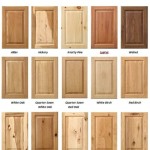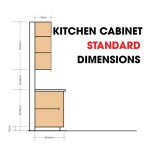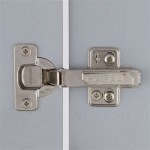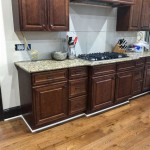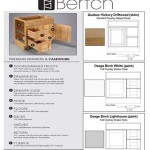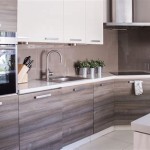How to Cover Kitchen Shelves Without Doors
Open shelving in kitchens has become a popular design choice, offering easy access to dishes and ingredients while creating a sense of spaciousness. However, open shelving can also expose items to dust, grease, and other kitchen elements. For those seeking a balance between open shelving's accessibility and the protection offered by closed cabinets, various solutions exist to cover kitchen shelves without installing doors.
Using Curtains or Fabric
Fabric offers a versatile and cost-effective way to conceal shelf contents. Different fabrics create varied aesthetics, from rustic linen to modern geometric prints. This method allows for easy access while adding a decorative touch to the kitchen.
- Measure the shelves accurately to determine the required fabric size.
- Select a fabric that complements the kitchen's décor and is easy to clean.
- Install a curtain rod or tension wire beneath the shelf above.
- Hang curtains using clips, rings, or by sewing a rod pocket.
- Consider using tiebacks for convenient access to shelf contents.
Applying Shelf Liners or Contact Paper
Shelf liners and contact paper serve a dual purpose: protecting shelves and enhancing their appearance. They are available in various patterns and colors, allowing for customization to match any kitchen style. This approach is particularly useful for concealing shelf imperfections or adding a pop of color.
- Clean the shelves thoroughly before applying any liner.
- Measure and cut the liner to fit the shelf precisely.
- Apply the liner carefully, smoothing out any air bubbles.
- Trim any excess liner for a clean, finished look.
Installing Bamboo Blinds or Shades
Bamboo blinds or shades offer a natural and textured alternative to fabric curtains. They provide privacy while allowing some light to filter through, maintaining a sense of openness. This option is particularly well-suited for kitchens with a bohemian or natural aesthetic.
- Measure the shelves carefully to ensure the blinds fit correctly.
- Mount the blinds inside the shelf frame or on the underside of the shelf above.
- Adjust the blinds to control the level of privacy and light filtering.
Utilizing Decorative Boxes and Baskets
Boxes and baskets provide a stylish and functional way to conceal shelf contents while adding storage solutions. They can be chosen to complement existing décor and offer different levels of concealment depending on material and design. This method is especially effective for organizing smaller items and creating a tidy appearance.
- Select boxes and baskets in varying sizes and materials to suit the items being stored.
- Label the containers for easy identification of contents.
- Arrange the containers aesthetically on the shelves.
Repurposing Wooden Crates
Wooden crates can be repurposed as rustic and charming shelf covers. They can be stained or painted to match the kitchen décor and offer a unique, personalized touch. This option is ideal for creating a farmhouse or vintage-inspired kitchen aesthetic.
- Choose crates of appropriate size and depth for the shelves.
- Sand and clean the crates before applying any finish.
- Secure the crates to the shelves if desired for added stability.
Employing Sliding Panels or Screens
Sliding panels or screens made of materials like frosted glass or acrylic offer a contemporary and sleek solution. They provide adjustable coverage and allow light to pass through, maintaining a sense of airiness. This option is well-suited for modern or minimalist kitchens.
- Install tracks or runners above or below the shelves to accommodate the sliding panels.
- Select panels that complement the kitchen's style and provide the desired level of privacy.
Creating a Faux Cabinet Look with Trim
Adding decorative trim or molding to the front of open shelves can create the illusion of cabinet doors. This method provides a more permanent solution and can significantly enhance the visual appeal of the shelves. It allows for customization in terms of style and color to match the existing kitchen cabinetry.
- Measure the shelf openings accurately to determine the required trim length.
- Cut and miter the trim pieces for a seamless fit.
- Attach the trim to the front edges of the shelves using wood glue or nails.
- Paint or stain the trim to match the kitchen cabinets.
Choosing the right method to cover kitchen shelves without doors depends on individual preferences, budget, and the overall kitchen design. Careful consideration of these factors will ensure a solution that is both functional and aesthetically pleasing.

How To Have Open Shelving In Your Kitchen Without Daily Staging The Inspired Room

Al Solution Two Budget Friendly Ways To Cover Open Shelves Dress Your Home S Top Decor Interior Design Blog

Al Solution Two Budget Friendly Ways To Cover Open Shelves Dress Your Home S Top Decor Interior Design Blog

Shelves Kitchen Cabinets Color Combination Without Doors

33 Smart No Door Kitchen Cabinet Ideas Shelterness

7 Ideas For Open Kitchen Cabinets With No Doors Block Guides

Upper Kitchen Cabinets Or Open Shelves For Your

How To Style Your Open Kitchen Shelving

How To Paint Your Kitchen Cabinets Without Losing Mind The Kim Six Fix

Kitchen Cupboards Without Doors The Best Design For Your Home Open Cabinets Upper

